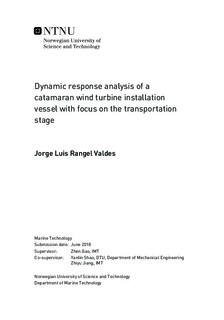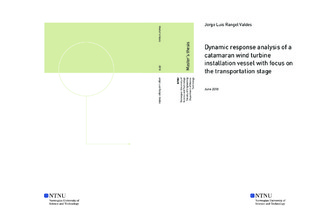| dc.description.abstract | The United Nations have agreed on the Sustainable Development Goals for the world where one of them is to achieve affordable and clean energy for the whole world for which wind energy would be a good option. Additionally, the price of wind power generation decreased its production costs and its demand has grown. Offshore sites are the best option to place wind farms since: the quality of the air for its energy use is better, there is a large free space to transport and maneuver with large structures, and the noise problem is avoided near populated places. Catamaran vessel designs have a superior capacity to trans-port loads with a high center of gravity, and that have a lower resistance to advance thanmono-hulls. MOVE has proposed the design of a catamaran-type vessel to transport andinstall four fully assembled wind turbines. From design perspective of a vessel or marinestructure, it is important to predetermine its behavior when it is subject to environmentalconditions, such as wind and waves in different directions.The objective of the thesis is to present how the dynamic analysis of the catamaran-typewind turbine installation vessel system with 4 wind turbines full assembly on board hasbeen performed, to know its behaviour in terms stability, sea-keeping motions, and stressfor a sea-fastening, on an early design stage.In addition, applying and, if possible, ensur-ing the fulfillment of the corresponding criteria.This, to contribute to the set of analysis ofcatamaran vessels as solution for the future of wind-turbine transportation that has beencarried at SFI-MOVE.The shape of the vessel was improved, the offset table lines smoothed and the mesh se-lected for the specific wave length. From this it was found that the stability of the shipfulfill the stability criteria selected for the ship, since there is no official criteria for theparticulars of the vessel, using the IS code 2008, part A and B, criteria that can be considermore than sufficient for this type of marine operations has been succeed.For the dynamic analysis the method stated in the correspondent chapter was followedand as a result the displacements, velocities and accelerations where obtained, where itwas shown that the values art the nacelle, where more than the 0.3g, which is the designlimit parameter.The sea fastening was design for beam and Shell elements, the beam elementss can beknow the displacement but no the stress. For the shell elements the sea fastening supportin x and z the accelerations but fail in the y direction.In conclusion; By performing a dynamic analysis, accurate accelerations can be obtained.This entails a reduction in risk and an increase in efficiency for all marine operations andtherefore a reduction in costs. And, additional systems should be implemented to reducethe accelerations, since, they are more than the tolerated for the design of the WT machin-ery | |

